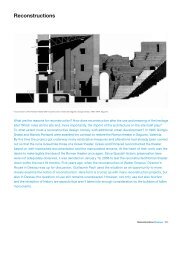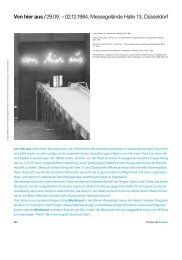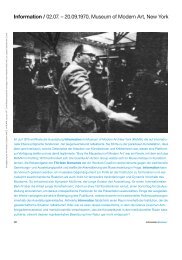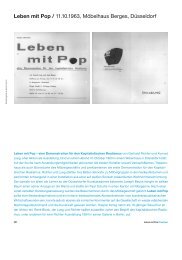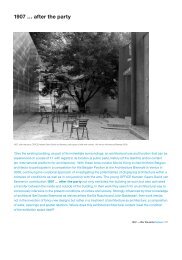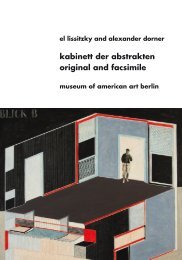Playground Surrealism
Playground Surrealism
Playground Surrealism
Create successful ePaper yourself
Turn your PDF publications into a flip-book with our unique Google optimized e-Paper software.
<strong>Playground</strong> <strong>Surrealism</strong>On the table of Madelon Vriesendorp’s studio-flat in London lies the preparatory drawing for Superpainting, 2008, her most recent painting.High-rises, sights, everyday objects, insects, figures—thousands of these things are spread out as miniatures orsouvenirs in artist Madelon Vriesendorp’s live-in studio. On the one hand, the collection puts together a contemporarycabinet of curiosities of comparable size and, on the other, provides the motifs for her paintings. In the early 1970sVriesendorp was living in New York, where she was one of the cofounders of Office for Metropolitan Architecture(OMA). In New York she put together an extensive collection of postcards and painted numerous gouaches, such asAprès L’amour and Flagrant Délit, which address the double morality of modern architecture. The latter work wasused to illustrate the cover of Rem Koolhaas’s Delirious New York (1978). In a mixture of Surrealistist depiction,illustration, and architectural rendering, the images shaped the visual idiom of the office’s early projects. Nevertheless,Madelon Vriesendorp is still an ‘almost unknown artistic genius’ (Hans-Ulrich Obrist). Her artistic oeuvre, which is alsoan essential contribution to a critical history of architecture, will be comprehensively exhibited for the first time in aretrospective at the Architectural Association in London and the Aedes Galerie Berlin. The curators of the exhibition,Shumon Basar and Stephan Trüby, ‘learnt as architects from Maddie that just because something is small and ismimetically related to something else in the world, it does not make it a ‘copy’ of that original thing. There is a humanityinvested in the souvenir that is just as heartfelt as the huge thing it refers to. The moment this souvenir enters your ownprivate space, it becomes a 1:1 architecture.’<strong>Playground</strong> <strong>Surrealism</strong> Displayer / 187
Madelon Vriesendorp/Shumon Basar/Stephan Trübyto Amsterdam, there was a very straightforward note inmy door, saying ‘come tomorrow to my place’ and I did.<strong>Playground</strong> <strong>Surrealism</strong>Madelon Vriesendorp in conversation with the curators ofThe World of Madelon Vriesendorp.<strong>Surrealism</strong> and RadicalitySHUMON BASAR/STEPHAN TRÜBY Madelon, to startout with a harmless question: Could you say somethingabout your roots, your family? Who in your family made abig impression on you in terms of a certain interest in art?MADELON VRIESENDORP My mother was from anartistic family and my paternal grandmother camefrom a family of horse-painters. My mother went toart school in The Hague. Later, in the Sixties, shebecame a writer and was part of the feminist movement.She also was a TV personality and did gameshows. She had a column in a paper and was wellknown. Her pseudonym was Harriet Freezer (pronounced‘Frazer’). My sisters are very talented artists.My paternal grandfather was a trained wood buyerand had traveled all over the world: Argentina, Russia,etc. Even though he was an introverted man, whotalked in telegram style sentences, I liked to go to hishouse with the old world furniture, the smell of hiscigars, the pictures.How did you come to art?I went to the art school in Amsterdam when I was 19.The school was later called Rietveld Academy and Istayed for three years. It was in the Sixties and wewere all involved in a massive rebellion.How did you meet your husband, the architect RemKoolhaas?I met him first when I was 17. Rem’s aunt was an artschool buddy of my mother’s. They had a big party andwe sat and talked the whole evening and I thought,wow, what a great guy to talk to, so intelligent andinterested in everything! Two years later, when I movedThe whole 1968 thing, did that register in your mind?Yes, of course. There was a great surge of protests.Rem was a journalist, writing for The Haagse Post. Hewas in Prague when the tanks were rolling in. Then wewent to Paris, out in the streets, we were just right inthe middle of the fighting, the barricades, giganticmarches. The whole of Europe seemed to be engagedin a protest against the authorities, America and theVietnam War.Which aspects of contemporary art in the Sixties made thebiggest impression on you?In art school everybody was obsessed with sex. Hotbedfor hot sex just about everywhere (laughs). Afamous writer was standing on a soapbox in the streetand shouting: ‘People have to screw more!’ There weredrugs of course, LSD, weed, etc. A friend of mine cameto school once in the morning after an all-night drugfest,carrying a big red painting and shouted: ‘God, thepainting was so much better yesterday!’How did you come in contact with <strong>Surrealism</strong>?Well, I was interested in Dalí, but more in the Surrealist’sforefathers like Bosch and Bruegel, Piranesi, evenIngres. Also of course: Magritte, Dick Ket, MaxBeckmann, Otto Dix, etc. So many inspiring contemporaryartists like Claes Oldenburg, Kitaj, Hockney. Agreat discovery was Domenico Gnoli, who did large,fantastic paintings of tiny details like a button andbuttonhole, very precisely painted. This extreme focuswas very humorous. Sort of opposite to the actionpainters, like Karel Appel; I couldn’t really relate to thisalpha-male obsession with picking a fight with yourcanvas, but I did enjoy the performance.Would you call yourself a surrealist?I would prefer not calling myself anything. But mydaughter Charlie suggested recently that I should callmy work ‘<strong>Playground</strong> <strong>Surrealism</strong>’. I really like that.188 / <strong>Playground</strong> <strong>Surrealism</strong> Displayer
Did you think about architecture during 68 and itsaftermath?I became interested in architecture through Rem. Hewas writing about architects like Le Corbusier,Wijdeveld, etc. Then he moved to the UK to study atthe AA School of Architecture. In the early Londonyears I was doing etchings and book-covers. Therewas some architecture in it: very thin-lined drawings.My first show in London was a group exhibition in theSerpentine Gallery, 1969.Could you describe the general atmosphere during yourfirst years in London?London was a strange place then, very English. Wewere called ‘continentals’. I felt you couldn’t buy anythingedible. There was no good bread, no coffee, onlytea. Now, everybody moves to London, but then,foreigners were in the minority.What was, for you, the biggest difference between theEnglish and the foreigners?Around 1970 I thought, what is this here? No black andwhite, everything just grey. We thought the problemwas words like ‘rather’ and ‘quite’. For the English,Rem and I were these horrendously painful andconfrontational people. We asked ‘yes or no?’ We wereperceived as radical because of our ‘European’behaviour; our harsh judgments, our outspokenness.I’m only just starting to fully understand the Englishand their sensitivities.But despite this you stayed in London. What attractedyou? Non-radical English people allowed you radicality?Yes, that’s it. A great capacity for tolerance, or is itindifference?a way back into architecture. That’s how his wife Zoe[Zenghelis] and I got involved.What was the first OMA drawing you did?First, I helped with doing collages and watercolours. Ithink the first piece I ever did for OMA was the collagefor Exodus, with idyllic LA villas with swimming poolson one side separated by this huge wall from the fumingindustrial horror on the other side.Please tell us more about your working relationship duringthe early OMA years, between you, Rem, Elia and ZoeZenghelis.The early OMA years we were collectively hectic,always deadlines, never enough time to do it all in.Everybody who came through the door had to give ahelping hand. Zaha [Hadid] collaborated on the Dutchparliament competition. Rem was definitely aninstigator of ideas, while Elia had his own thing going,quietly doing his genius scheme, the drawing to end alldrawings. Often he would start a new one just beforewe had to send the whole thing off, singing away. Wecouldn’t work without singing along to the latestsongs; Stevie Wonder, Marvin Gaye, Roberta Flack, etc.Was there anything like a theoretical or ideological commonground during the first OMA years?The most important common ground for us was theadmiration for the Russian constructivists, especiallyLeonidov and Malevich. Leonidov was an eye-openerfor Rem. He was visionary and at the same time verysurreal; if you look at his Narkomtjazhprom skyscraperproject with these strange mushrooms stuck to thefaçade, outrageous scale; a combination of exquisitebeauty and extreme vision.Filling the gapsHow did OMA come together?The collaboration started with our entry for Casabella’s1972 competition, The City as a Meaningful Environment.Rem and Elia [Zenghelis] called it Exodus, or theVoluntary Prisoners of Architecture. For Rem it was hisfinal project at the AA, and for Elia, Rem’s tutor, it wasWhat role did OMA play within the early Seventies AAcontext?I think, the early work of OMA can only be understoodas a reaction against provincial hippydom, sentimentalhumanism; ’human’ scale and Archigram’s have-funstylewith masses of cute happy people in their collages.To us then: sickening loveliness.Madelon Vriesendorp/Shumon Basar/Stephan Trüby / 189
How does Superstudio fit in that picture?Superstudio was a great antidote to all that! The ContinuousMonument took Modernism to its limits. Reminvited Adolfo [Natalini] to give a lecture at the AA in1971. There was a lot of grumbling: ’Why does thisDutch-man bring over these Italian fascists?’ Thelecture was very funny, nobody understood his accent;he had written it down and read everything veryslowly. For us the important question was: What isinside the Continuous Monument? What is happeningthere? It was something exciting and surreal, withinfinite possibilities!Around 1968 you were involved in protests againstAmerica; a few years later, around 1972 you went to theStates. Why did you, after the Russian constructivists,decide to ’go west’?New York was such unpopular terrain then! Thewhole Sixties thing ran against big business and the’inhumane’ skyscrapers of New York. The reason thatwe went there was because of Rem’s early obsessionwith New York, his plan to write about it and his wish tostudy with Oswald Mathias Ungers at Cornell University,Ithaca, New York.Rem Koolhaas published Delirious New York in 1978.Could you describe your involvement in that book?I did some drawings for it, and I was involved in theresearch. The research was the most exciting thing.We found a couple who lived in a caravan in Geneva,New York, and who owned almost nothing else exceptpostcards. They worked in the night, but you couldmeet them at five o’clock in the afternoon, that’s whenthey got up. Every cupboard in that caravan wasstacked with boxes of postcards. We found the mostamazing cards.Was it clear from the beginning that your paintings wouldbe part of Delirious New York?No, not at all. This became clear just at the very lastmoment. Flagrant Délit, the painting that later becamethe cover of Delirious New York, was first used, withoutpermission, on the cover of an Italian book on skyscrapers.The editor from Oxford University Press sawthis book at the book fair in Frankfurt and suggestedto put this painting on the cover. Originally, it wasplanned to put a photograph of the Edison Pavilion fromthe New York World’s Fair of 1939 on the front cover.Could you describe the relationship between DeliriousNew York and your paintings?Well, obviously these paintings aren’t just an illustrationof the text. It is funny that Rem used all three paintingsbecause he could have just used Flagrant Délit. Then hefound something in every one of them. The productionof my paintings was interacting with the changingarguments of the book. Rem asked me to putRockefeller Center in, so I did a new painting with theRCA Building. Even though the decision to include thepaintings in the book was made in the final stage of itsproduction, the paintings were in a way a confirmationof his theories. A planned version of the Paranoid-Critical Method: creating evidence.Your paintings seem to be something like the sentence’quod erat demonstratum’ in mathematical formulas...Maybe. He wrote the book on New York with thismethod, everything he found entirely proved his point;of course it tells you something about where and whatyou are looking for. He discovered the Paranoid-CriticalMethod when he read My Secret Life after coming backfrom a trip to Russia with the flu. Dalí and a high feverwas a lethal but totally inspiring combination. Hallucinatingat a fever pitch. Then he realized how theParanoid-Critical Method was used in every field ofscience and speculation. One can prove just aboutanything as one can always find enough evidence forone’s preconceived ideas, with mathematical precision.Everything falls neatly into place. Contradictionbecomes confirmation. There starts a lifelong’contradiction addiction’.Your reservations against hippies are surprising becausesome of the ’hippie artists’, Marti Klarwein for example,were also influenced by surrealism...We weren’t too much interested in hippies, nor in their190 / <strong>Playground</strong> <strong>Surrealism</strong> Displayer
in that sense they’re very close [laughs]. Of course weinfluence each other, but S,M,L,XL is entirely a productof the OMA office. I thought about making a bookcalled XS, but then I saw that somebody else did it.You have two big tables, full of figures and architectures—almost like the Manhattan skyline outside the window inFlagrant Délit. They all look in the same direction. Onegets the impression that all the figures are watching you.The word ‘paranoia’ comes into the mind...Of course there has to be a certain madness to do this.Everybody nurtures his own madness, in a way. I likethe idea of objects and things that particularly saysomething to you.The last home of Sigmund Freud, 20 Maresfield Gardens,is just a few hundred meters away from your flat. Insideone can find something comparable to your flat: acompletely crammed desk, surrounded by archeologicalfigures which formed a silent audience for Freud...Yes, but I am collecting the trash version of Freud’scollection. He had the things that really spoke insymbols—Egyptian, Roman, and Greek stuff... I’m sureif Freud were alive, he would be very interested inpopular culture.What is this other reality you are talking about? Is yourspace a representation of something bigger, maybe thedomestic version of Manhattan’s culture of congestion?This description might be too literal. It is mainly abouthaving those things around that I find interesting orinspiring.Did you get in touch with the anti-psychoanalysis movementof—let’s say—Deleuze and Guattari? They literallywanted to open the window of the closed room ofpsychoanalysis, of father—mother—child...With these movements I agree insofar as Freud’smethod does not seem to work anymore. He has beensucceeded. Of course he was very important, butmainly against a 19th century background of repression.People are like mushrooms. Mushrooms pop upin places where they are necessary. Nowadaysmushroom Freud may have become obsolete. But hiswriting has to be read and reread as it is still one ofthe most stimulating sources of information andspeculation.The interview is based on a conversation in North-London,August, 2007.Following Freud, many surrealists crammed their flats andstudios with interesting objects, André Breton, for example,in the Rue Fontaine in Paris...Yes, all artists collect. You always look for thingsthat inspire you. Every artist is looking for analternative reality...Shumon Basar, Stephan Trüby (Hg.): The World of Madelon Vriesendorp. Paintings/Postcards/Objects/Games, London 2008.Shumon Basar, Hans-Jürgen Commerell, Kristin Feireiss, Stephan Trüby (Hg.): Madelon Vriesendorp:Flagrant Délit Or Dream of Liberty, Berlin 2008.Jean-Pierre Jacquet, Madelon Vriesendorp, Teri Wehn-Damisch: Flagrant Délit. The Dream of Liberty,Animation, 35mm, Farbe, 10 Minuten, FR 1979–80.Rem Koolhaas: Delirious New York. A Retroactive Manifesto for Manhattan, New York, Paris 1978.192 / <strong>Playground</strong> <strong>Surrealism</strong> Displayer
Madelon Vriesendorp/Shumon Basar/Stephan Trüby / 193
010203 0401 Eine von zwei nach Größen geordnete Zusammenstellung der Miniatur-Architekturenund Figuren.02 Detail aus der Sammlung von Objekten im Wohnatelier von Madelon Vriesendorp.03-04 Präsentation der Sammlung von Madelon Vriesendorp in der Ausstellung TheWorld of Madelon Vriesendorp. Paintings/Postcards/Objects/Games in der ArchitekturgalerieAedes am Pfefferberg, Berlin, 14.03. – 17.04.2008.194 / <strong>Playground</strong> <strong>Surrealism</strong> Displayer
0505 Ausschnitt aus dem Storyboard des Animationsfilms Flagrant Délit or the Dream of Liberty für das französische Fernsehen, 1979–80.Madelon Vriesendorp/Shumon Basar/Stephan Trüby / 195



